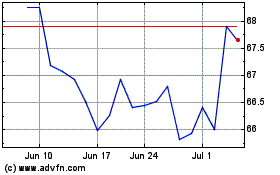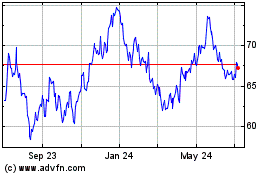BHP Shares Sink After Brazil Dam Bursts
November 06 2015 - 1:20AM
Dow Jones News
SYDNEY—Shares in BHP Billiton Ltd., the world's biggest mining
company by market value, fell by up to 5.4% Friday as investors
fretted about the damage to a Brazilian iron-ore operation it
jointly owns caused by a major dam burst there.
Australia-based BHP said it "understands that a serious incident
[had] occurred" at Samarco Mineraç ã o SA's iron-ore operation in
the Minas Gerais state. BHP holds a 50% interest in Samarco, with
the rest owned by Brazil's Vale SA.
A local network reported that as many as 16 people may have died
in the flooding following the accident at the dam, which occurred
at 4.20 pm local time on Thursday. Television images from Brazil
showed footage of heavy trucks being overturned and homes awash in
red mud around the area close to the dam.
The structure that failed is what is known as a tailing dam,
used to hold water and discarded minerals from a nearby iron-ore
mine. The dam is operated by Samarco.
While the cause and full impact of the accident are as yet
unclear, investors feared it could shut down the mine for some
time, said Angus Nicholson, a Melbourne-based analyst at broker IG.
BHP's Australia-listed shares were recently down 2.8%, compared
with a 0.3% rise in the broader Australian market. The company is
dual-listed in Sydney and London.
"It could be a significant amount of time before it [Samarco]
gets back to production, so I am only surprised we haven't seen a
bigger selloff," said Mr. Nicholson.
Samarco is an important business for BHP, accounting for roughly
3% of annual earnings and 5% of valuation—a meaningful unit for
such a large company, said Australian bank Macquarie.
In the year through June, the venture contributed US$695 million
to BHP's underlying earnings and generated a total US$1.41 billion
in revenue. Macquarie values Samarco at US$6.2 billion.
"The dam failure is a major concern and could have a material
impact on the near-term production outlook for Samarco," it said in
a client note. BHP is one of the world's biggest producers of iron
ore globally. Its earnings have been hit by a slump in prices for
the commodity since the start of last year, although both it and
fellow mining giants Vale and Rio Tinto PLC have continued to
increase their output.
Samarco produces about 29 million metric tons of iron ore, and
is one of Brazil's biggest deposits of the steelmaking commodity.
It has enough reserves to last for more than three decades, at
current rates of production.
"We are in the process of obtaining more details from Samarco
Mineraç ã o" about the incident, BHP said in a statement. Samarco
isn't directly run by the global mining giants, but is operated as
a separate company, with BHP and Vale joint shareholders.
BHP said it was concerned for the safety of employees and the
local community and that it would provide more information as soon
as it can.
A spokesman for Vale declined to comment, pointing to a
statement by Samarco that said the venture was prioritizing helping
people and mitigating damage to the environment and that it wasn't
yet possible to confirm the cause of the incident.
Mining accidents aren't uncommon in the region. In January 2007,
the collapse of a tailings dam owned by Mineraç ã o Rio Pomba
Cataguases Ltda. resulted in catastrophic flooding that left
thousands homeless in the cities of Miraí and Muriaé .
But such events are a rarity for mining giant BHP, which prides
itself on high safety standards. Still, in the year through June it
recorded five worker fatalities, compared with none the 12 months
prior. It said it had since implemented a new company-wide safety
program.
IG's Mr. Nicholson said the market reaction was closely tied to
worries BHP would produce less iron ore this year, rather than any
issue with group management. "BHP has a much better [safety] track
record than many smaller miners," he said.
Write to Rhiannon Hoyle at rhiannon.hoyle@wsj.com
Subscribe to WSJ: http://online.wsj.com?mod=djnwires
(END) Dow Jones Newswires
November 06, 2015 01:05 ET (06:05 GMT)
Copyright (c) 2015 Dow Jones & Company, Inc.
Rio Tinto (NYSE:RIO)
Historical Stock Chart
From Aug 2024 to Sep 2024

Rio Tinto (NYSE:RIO)
Historical Stock Chart
From Sep 2023 to Sep 2024
